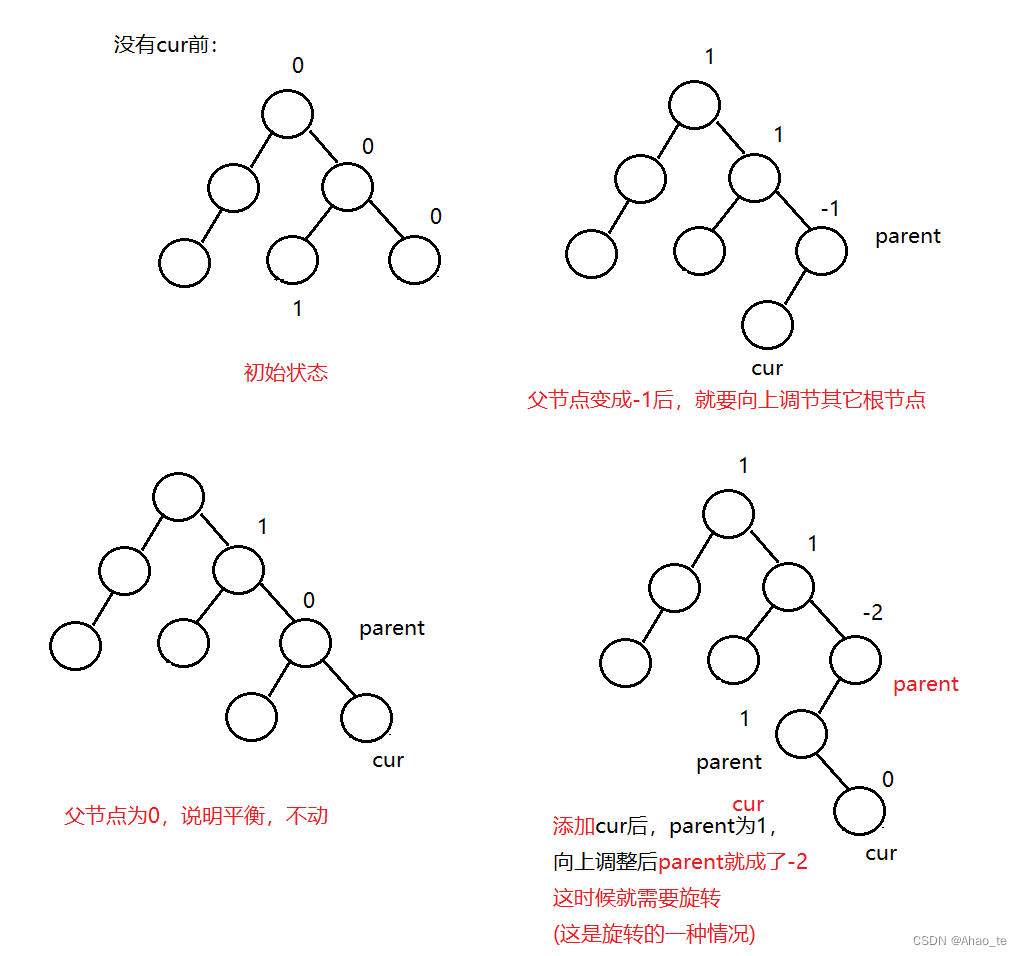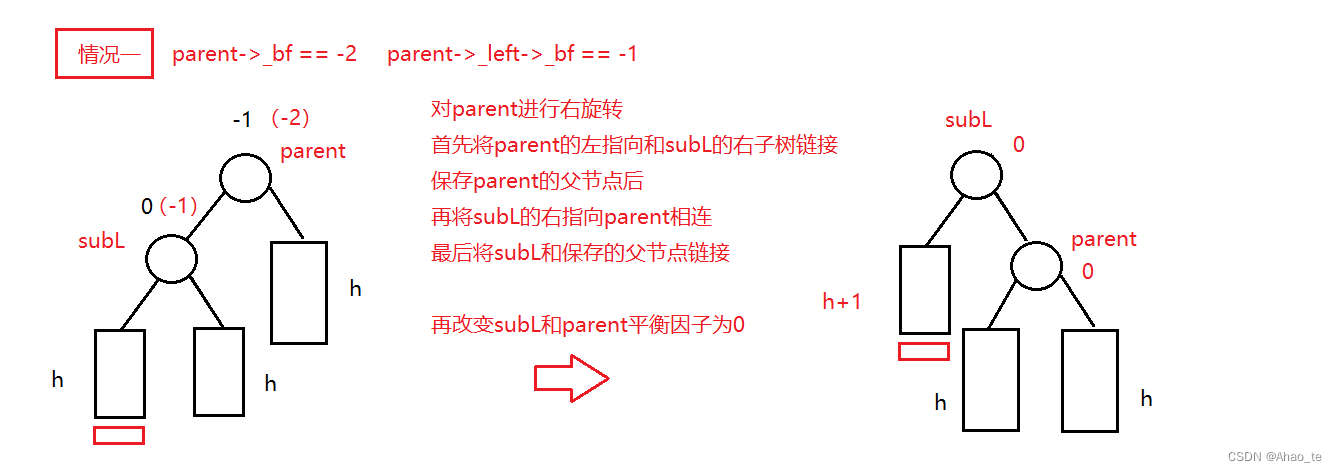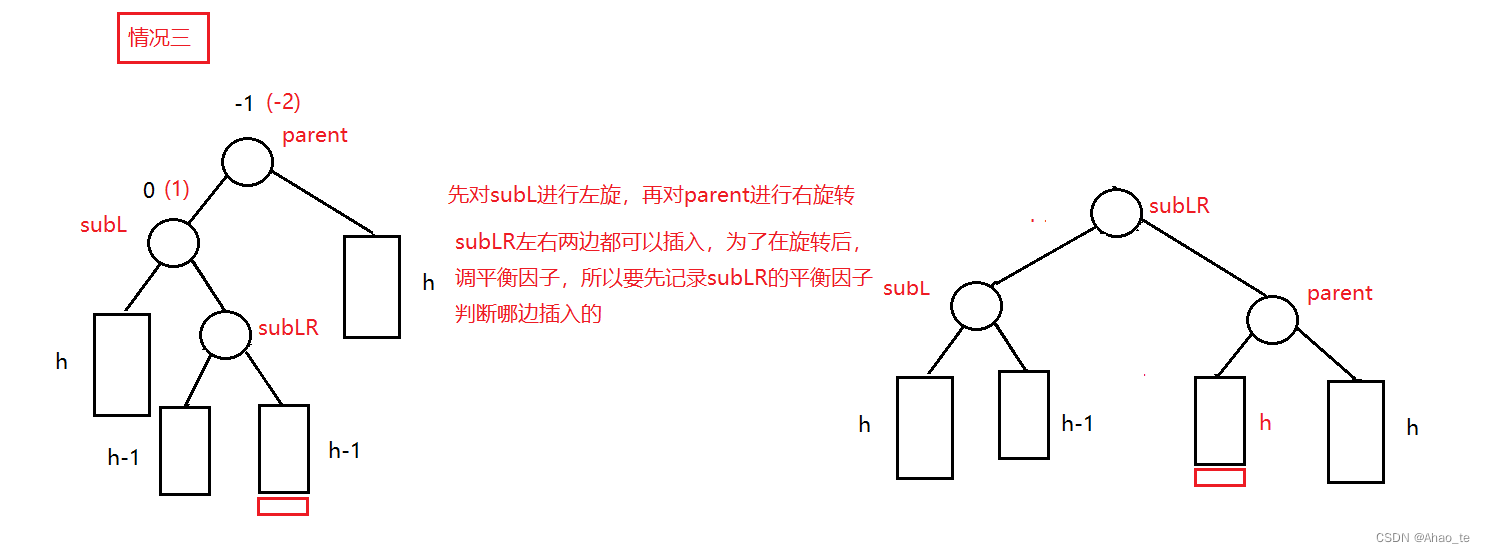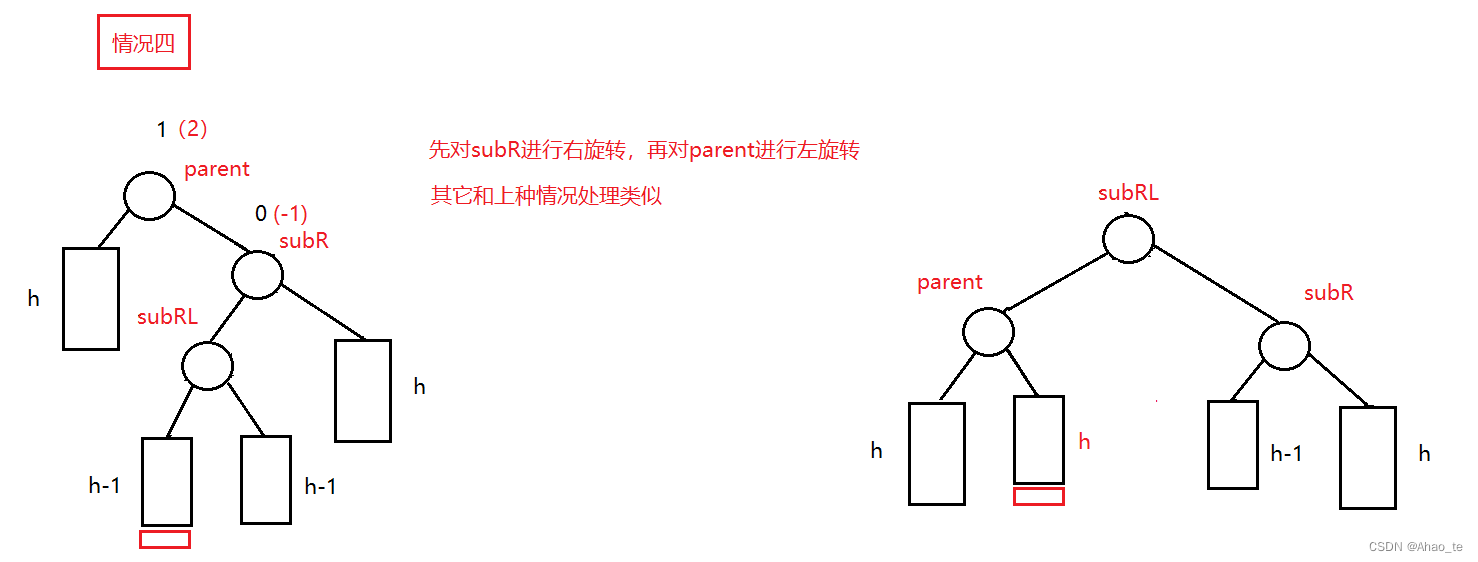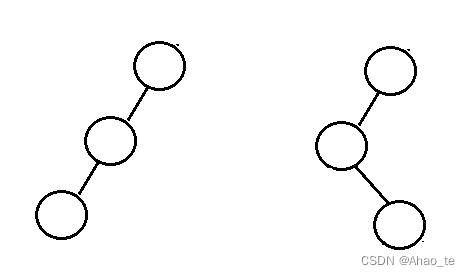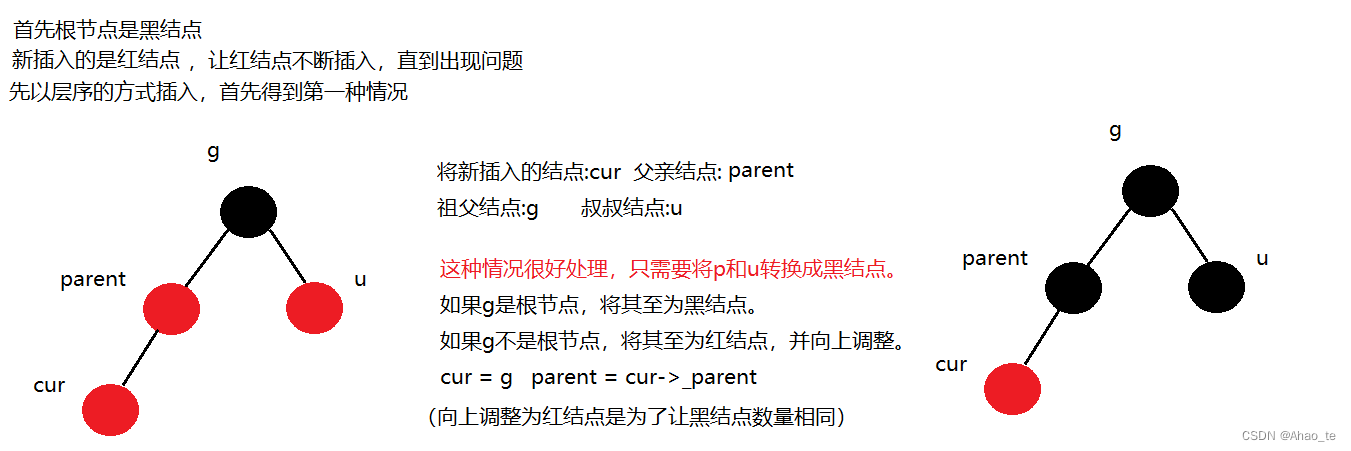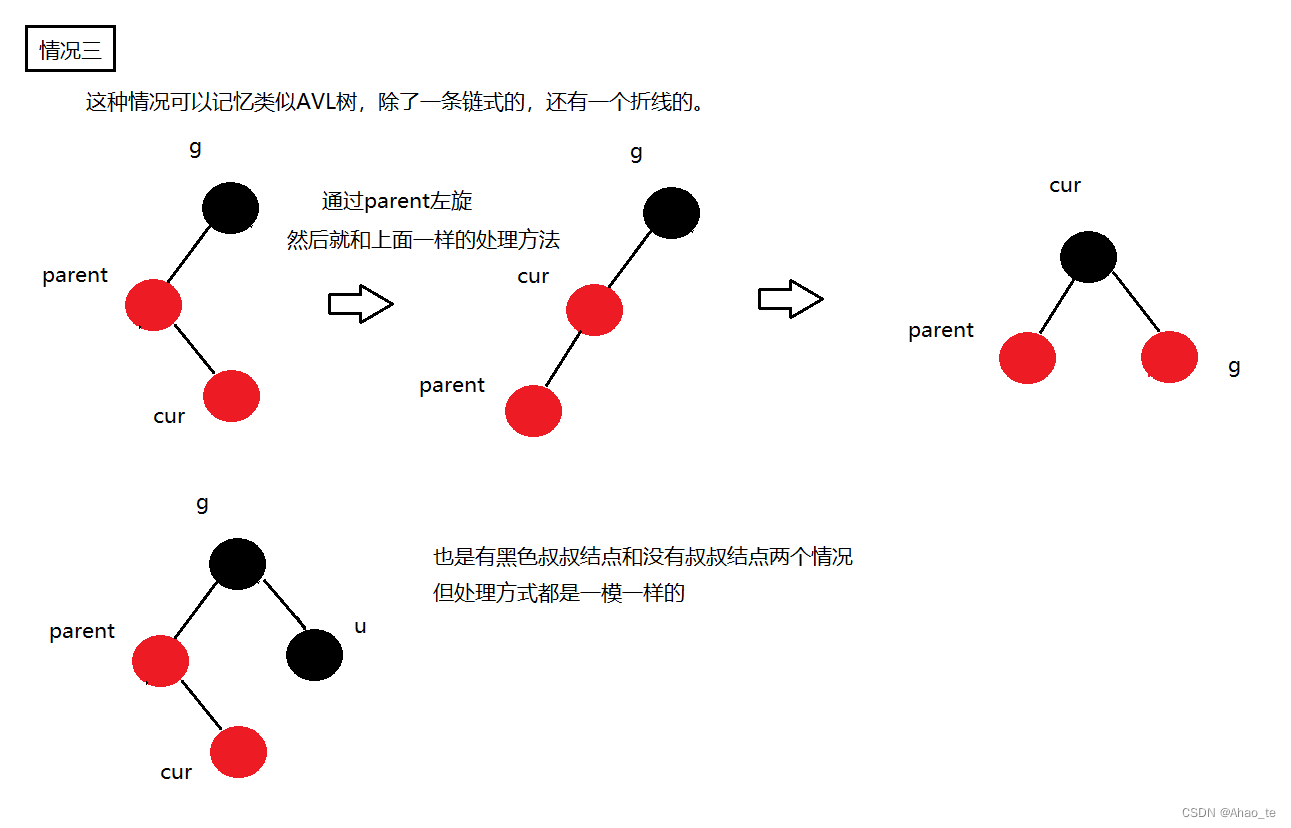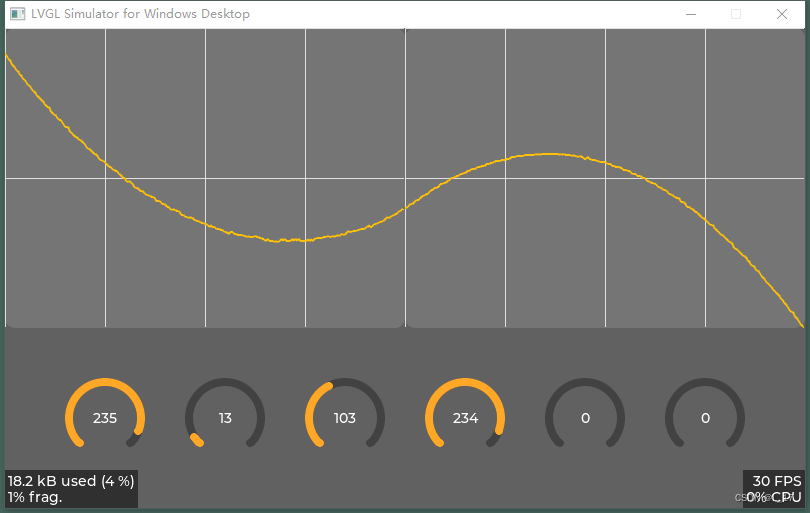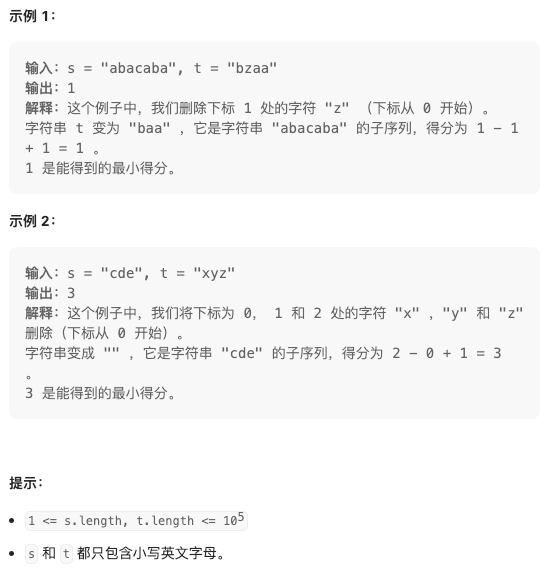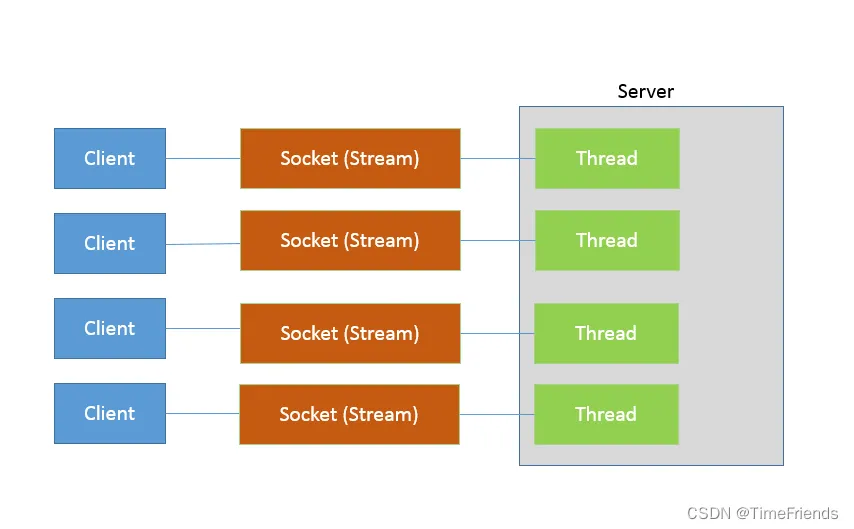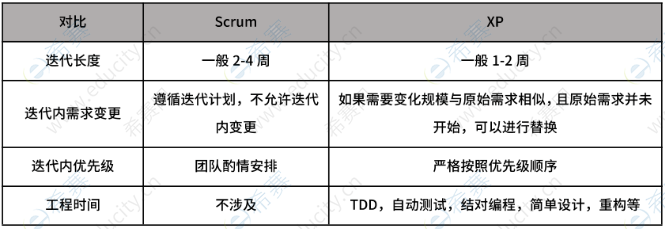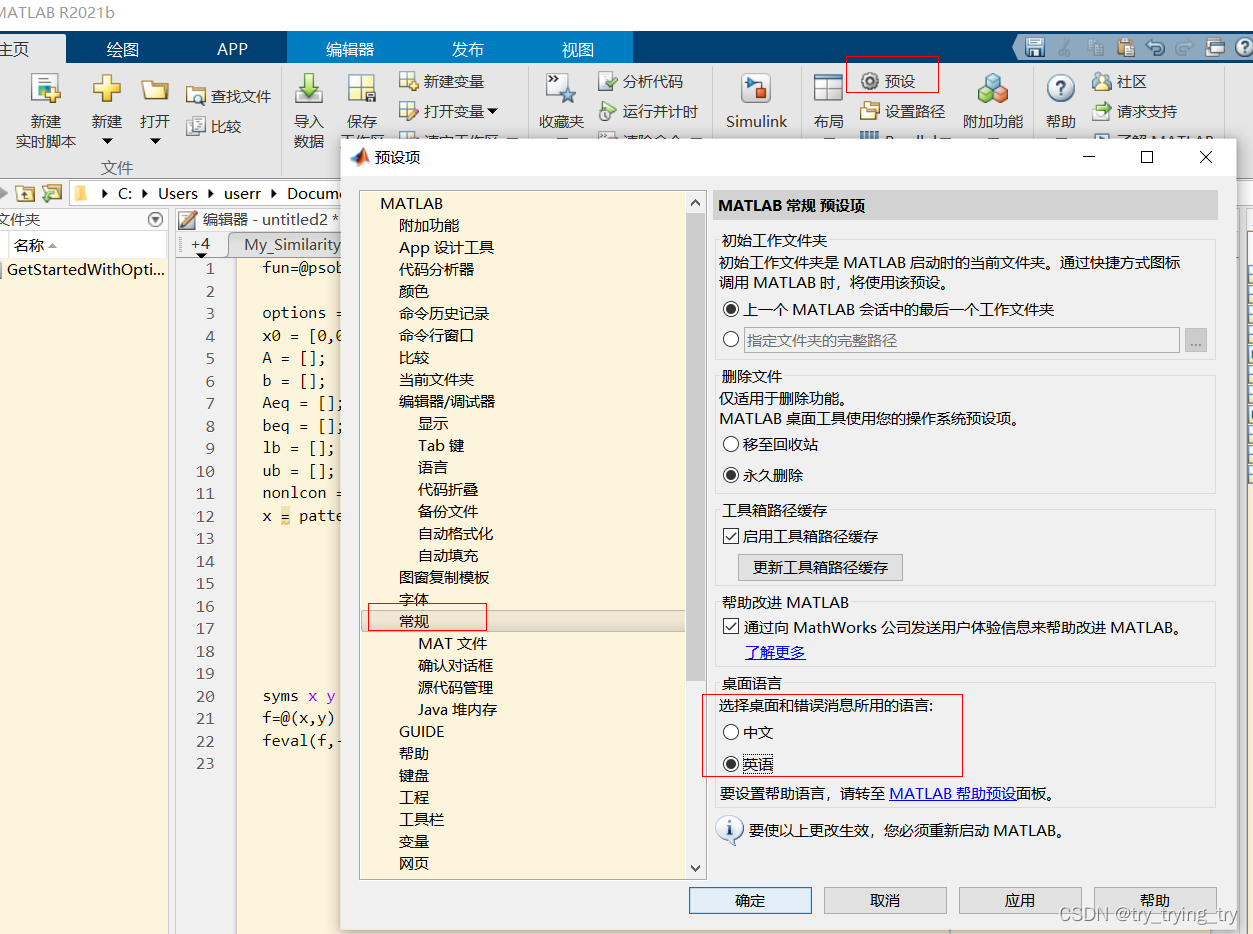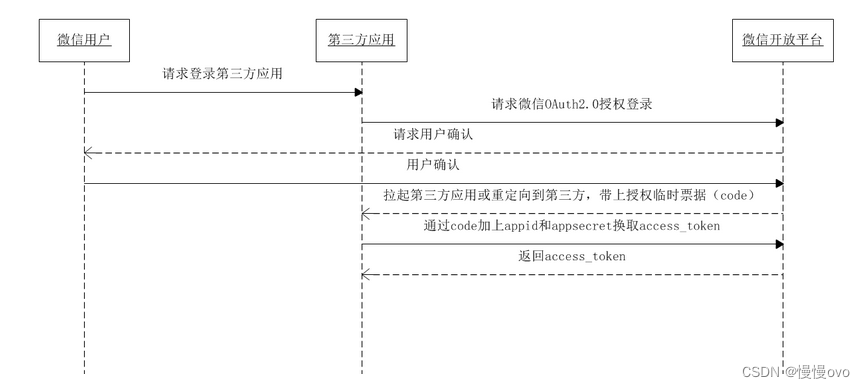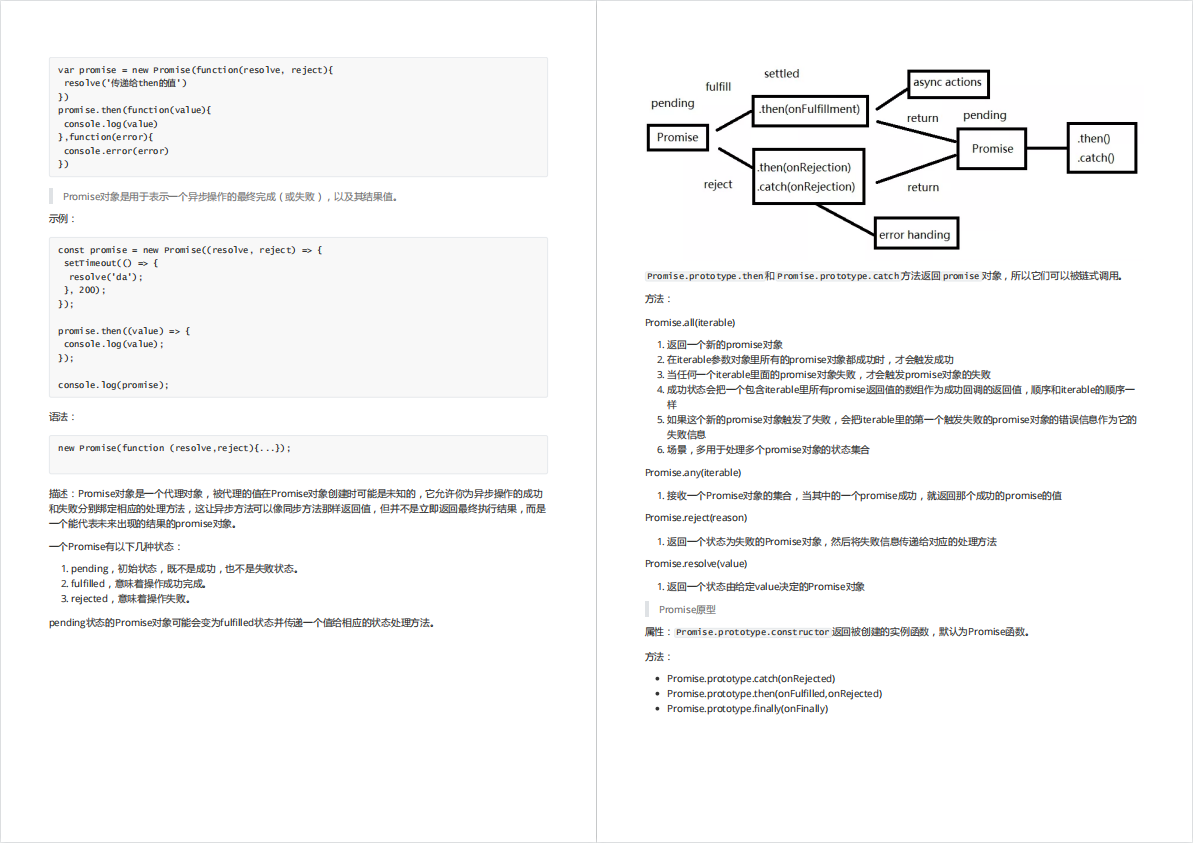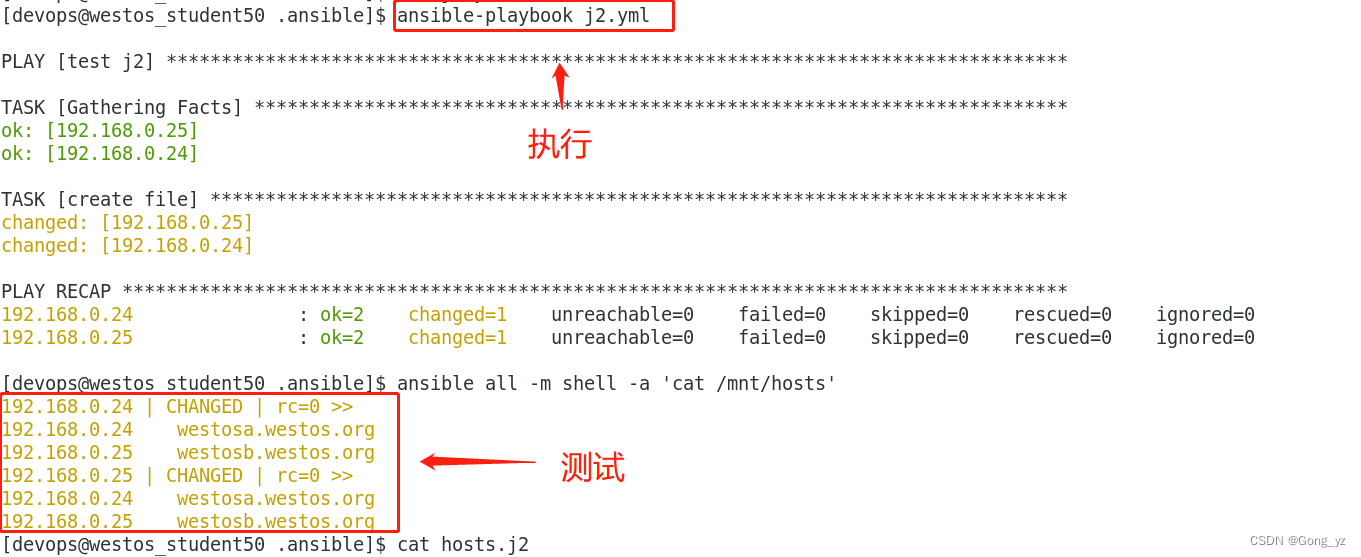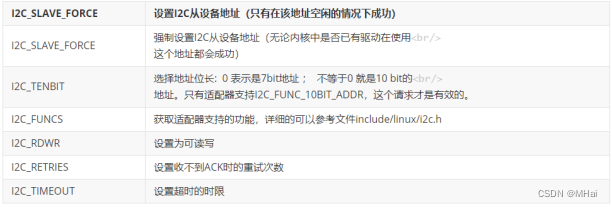文章目录
- 1、AVL树
- 1.1 AVL树的插入
- 1.2 总结与测试AVL树
- 2、红黑树
- 2.1 红黑树的插入
- 2.2 红黑树的测试
了解AVL树是为了了解红黑树,了解红黑树是为了更好的理解set和map。
1、AVL树
AVL树是在二叉搜索树的基础上进行了严格的平衡,能做到平衡的关键是通过平衡因子以及旋转。
AVL树有以下特性:
- 任何根的左右子树高度之差(简称平衡因子)的绝对值不超过1(-1/0/1)。
- 其中平衡因子是用右子树高度减去左子树高度。
- 任何子树都是AVL树。
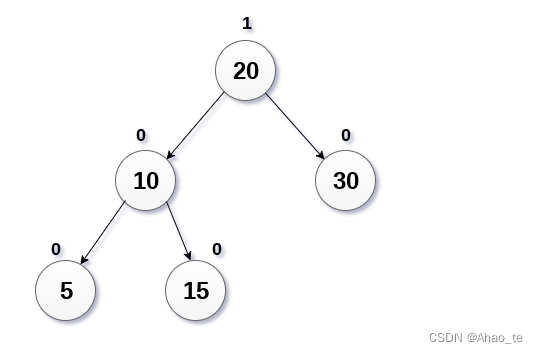
下面实现的AVL树还是KV结构的。
AVL树节点定义
#include <iostream>
#include <assert.h>
using namespace std;
template<class K, class V>
struct AVLTreeNode
{
//三叉链结构方便访问父节点
struct AVLTreeNode<K, V>* _left;
struct AVLTreeNode<K, V>* _right;
struct AVLTreeNode<K, V>* _parent;
pair<K, V> _kv; //键值对 里面存储key和value
int _bf; //平衡因子
AVLTreeNode(const pair<K, V>& kv)
:_left(nullptr)
,_right(nullptr)
,_parent(nullptr)
,_kv(kv)
,_bf(0)
};
template<class K, class V>
class AVLTree
{
typedef AVLTreeNode<K, V> Node;
public:
private:
Node* root = nullptr;
};
1.1 AVL树的插入
1、AVL树的插入首先一开始和二叉搜索树的插入一样,先确定插入的位置,再和父节点链接。
2、插入完后,可能会破坏AVL树结构,所以要判断平衡因子。
插入新结点后,平衡因子会出现三种情况。
3、当平衡因子出现了-2或2的情况,这个时候就需要对parent进行旋转。
旋转有以下情况。
bool insert(const pair<K, V>& kv)
{
if (_root == nullptr)
{
_root = new Node(kv);
return true;
}
Node* cur = _root;
Node* parent = _root;
while (cur)
{
if (cur->_kv.first < kv.first)
{
parent = cur;
cur = cur->_right;
}
else if (cur->_kv.first > kv.first)
{
parent = cur;
cur = cur->_left;
}
else
{
return false;
}
}
cur = new Node(kv);
//只能用kv值来确定parent和cur的指向
if (parent->_kv.first < kv.first)
{
parent->_right = cur;
cur->_parent = parent;
}
else
{
parent->_left = cur;
cur->_parent = parent;
}
//判断平衡因子
while (parent)
{
if (parent->_left == cur)
{
//根节点左边插入节点,根的平衡因子-1
parent->_bf--;
}
else
{
//根节点右边插入节点,根的平衡因子+1
parent->_bf++;
}
//说明之前是-1或1,变为平衡
if (parent->_bf == 0)
{
break;
}
else if (parent->_bf == 1 || parent->_bf == -1)
{
//下面子树高度差也影响了上面的根结点,所以需要向上调整
cur = parent;
parent = cur->_parent;
}
else if (parent->_bf == 2 || parent->_bf == -2)
{
//这个时候就需要旋转,使得树平衡
if (parent->_bf == -2 && cur->_bf == -1)
{
//这是右旋转的情况
RotateR(parent);
}
else if (parent->_bf == 2 && cur->_bf == 1)
{
RotateL(parent);
}
else if (parent->_bf == -2 && cur->_bf == 1)
{
RotateLR(parent);
}
else if (parent->_bf == 2 && cur->_bf == -1)
{
RotateRL(parent);
}
else
{
assert(false);
}
//旋转完后,结构平衡,退出
break;
}
else
{
//如果平衡因子出现其它情况,说明错了
assert(false);
}
}//while
return true;
}
旋转:
//右旋转
void RotateR(Node* parent)
{
//从下到上依次修改
Node* sub = parent->_left;
Node* subR = sub->_right;
//先改变最下面的subR结点
parent->_left = subR;
if (subR)
{
subR->_parent = parent;
}
//再改变parent结点
sub->_right = parent;
Node* ppnode = parent->_parent;
parent->_parent = sub;
//最后改变sub结点
if (ppnode == nullptr)
{
_root = sub;
_root->_parent = nullptr;
}
else
{
if (ppnode->_left == parent)
{
ppnode->_left = sub;
}
else
{
ppnode->_right = sub;
}
sub->_parent = ppnode;
}
parent->_bf = sub->_bf = 0;
}
//左旋和右旋类似
void RotateL(Node* parent)
{
Node* sub = parent->_right;
Node* subL = sub->_left;
parent->_right = subL;
if (subL)
{
subL->_parent = parent;
}
sub->_left = parent;
Node* ppnode = parent->_parent;
parent->_parent = sub;
if (ppnode == nullptr)
{
_root = sub;
_root->_parent = nullptr;
}
else
{
if (ppnode->_left == parent)
{
ppnode->_left = sub;
}
else
{
ppnode->_right = sub;
}
sub->_parent = ppnode;
}
parent->_bf = sub->_bf = 0;
}
void RotateLR(Node* parent)
{
Node* subL = parent->_left;
Node* subLR = subL->_right;
//保存subLR的平衡因子,为了知道从subLR哪边插入
int bf = subLR->_bf;
RotateL(parent->_left);
RotateR(parent);
if (bf == -1) // subLR左子树新增
{
subL->_bf = 0;
parent->_bf = 1;
subLR->_bf = 0;
}
else if (bf == 1) // subLR右子树新增
{
parent->_bf = 0;
subL->_bf = -1;
subLR->_bf = 0;
}
else if (bf == 0) // subLR自己就是新增
{
parent->_bf = 0;
subL->_bf = 0;
subLR->_bf = 0;
}
else
{
assert(false);
}
}
//和上面类似
void RotateRL(Node* parent)
{
Node* subR = parent->_right;
Node* subRL = subR->_left;
int bf = subRL->_bf;
RotateR(parent->_right);
RotateL(parent);
if (bf == -1) // subRL左子树新增
{
subR->_bf = 1;
parent->_bf = 0;
subRL->_bf = 0;
}
else if (bf == 1) // subRL右子树新增
{
parent->_bf = -1;
subR->_bf = 0;
subRL->_bf = 0;
}
else if (bf == 0) // subRL自己就是新增
{
parent->_bf = 0;
subR->_bf = 0;
subRL->_bf = 0;
}
else
{
assert(false);
}
}
可能会有的问题解释(以下是自己的理解):
1、如何想到旋转的情况?
其实从所有情况看就这两个情况以及他们的翻转,记住它们两个就好了。
2、如何看左右旋?
拿上图举例,左边是一个右旋能平衡的场景,只需要将最高的结点往右放就行。
右边是一个双选的场景,先将中间结点左旋,就成了图左边的场景,再右旋就行。
1.2 总结与测试AVL树
AVL树重点关注的是其平衡因子和选择如何使得AVL树平衡,通过插入了解就足够了。
下面是如何测试结果是AVL树:
1、通过每个结点的左右子树的高度判断平衡因子是否符合要求。
2、通过小和大的测试用例测试是不是AVL树
#pragma once
#include <iostream>
#include <assert.h>
using namespace std;
template<class K, class V>
struct AVLTreeNode
{
struct AVLTreeNode<K, V>* _left;
struct AVLTreeNode<K, V>* _right;
struct AVLTreeNode<K, V>* _parent;
pair<K, V> _kv;
int _bf;
AVLTreeNode(const pair<K, V>& kv)
:_left(nullptr)
,_right(nullptr)
,_parent(nullptr)
,_kv(kv)
,_bf(0)
{}
};
template<class K, class V>
class AVLTree
{
typedef AVLTreeNode<K, V> Node;
public:
bool insert(const pair<K, V>& kv){}
void RotateR(Node* parent){}
void RotateL(Node* parent){}
void RotateLR(Node* parent){}
void RotateRL(Node* parent){}
int Height(Node* root)
{
if (root == nullptr)
{
return 0;
}
int leftHight = Height(root->_left);
int rightHight = Height(root->_right);
return leftHight > rightHight ? leftHight + 1 : rightHight + 1;
}
bool IsBalanceTree()
{
return _IsBalanceTree(_root);
}
bool _IsBalanceTree(Node* parent)
{
if (parent == nullptr)
{
return true;
}
int leftHight = Height(parent->_left);
int rightHight = Height(parent->_right);
int diff = rightHight - leftHight;
if (diff != parent->_bf || (diff > 1 || diff < -1))
{
cout << "有错" << endl;
return false;
}
return _IsBalanceTree(parent->_left) && _IsBalanceTree(parent->_right);
}
void Inorder()
{
_Inorder(_root);
}
void _Inorder(Node* root)
{
if (root == nullptr)
return;
_Inorder(root->_left);
cout << root->_kv.first << ":" << root->_kv.second << endl;
_Inorder(root->_right);
}
private:
Node* _root = nullptr;
};
//出错用小用例调
void test1()
{
int arr[] = { 4, 2, 6, 1, 3, 5, 15, 7, 16, 14 };
int arr2[] = { 16, 3, 7, 11, 9, 26, 18, 14, 15 };
AVLTree<int, int> t;
for (auto& e : arr)
{
if(e == 18)
{
//调试断点
int a = 0;
}
t.insert(make_pair(e, e));
t.IsBalanceTree();
}
t.Inorder();
}
//没错用多数据看看能不能过
#include <cstdlib>
void test2()
{
srand(time(NULL));
AVLTree<int, int> t;
for (int i = 0; i < 100000; ++i)
{
int num = rand() % 10000;
t.insert(make_pair(num, num));
}
t.IsBalanceTree();
}
2、红黑树
AVL树因为其严格的平衡导致它因为大量的旋转导致效率相较红黑树低。
红黑树不要求严格平衡,它为每个结点加上颜色区分,使得它趋向于平衡。它有着以下规定。
- 根节点必须是黑色。
- 根节点颜色要么是红色,要么是黑色。
- 红色结点不能连续。(也就是如果一个结点是红的,其两个子结点都是黑的)
- 每条路径下的黑色结点树要一样。
- 叶子结点都是黑色结点(这里叶子结点代表NULL结点)

可能概念理解起来很抽象,我们通过代码一步步来。
首先搭建红黑树的框架。
大致和AVL树一样,只不过没有平衡因子,换成了颜色。
#include <iostream>
#include <assert.h>
using namespace std;
enum Color { RED, BLACK };
template<class K, class V>
struct RBTreeNode
{
struct RBTreeNode<K, V>* _left;
struct RBTreeNode<K, V>* _right;
struct RBTreeNode<K, V>* _parent;
pair<K, V> _kv;
Color _col;
RBTreeNode(const pair<K, V>& kv)
:_kv(kv)
, _left(nullptr)
, _right(nullptr)
, _parent(nullptr)
, _col(BLACK)
{}
};
template<class K, class V>
class RBTree
{
typedef RBTreeNode<K, V> Node;
public:
private:
Node* _root = nullptr;
};
2.1 红黑树的插入
1、首先如果根是空,新建的结点一定是黑色结点。这很好理解。
2、那么如果是后面创建的结点,是黑色还是红色呢?
2.1 如果是黑色结点,那么想象一下,给某个路径添加一个黑色结点,使得这个路径的黑结点数量和其他路径不同,直接导致整个树不满足红黑树条件,直接破坏整个红黑树。
2.2 如果是红色结点,最差只会出现两个红色结点相连的情况,只影响这个子树。
所以综上选择影响最少的,选择创建红色结点。
3、插入前面和搜索树一样,得先确认插入的位置,以及和父节点链接。
4、调整红黑树
除此以外当然还有翻转的另一类情况。
bool insert(const pair<K, V>& kv)
{
if (_root == nullptr)
{
_root = new Node(kv);
_root->_col = BLACK;
return true;
}
Node* cur = _root;
Node* parent = _root;
while (cur)
{
if (cur->_kv.first < kv.first)
{
parent = cur;
cur = cur->_right;
}
else if (cur->_kv.first > kv.first)
{
parent = cur;
cur = cur->_left;
}
else
{
return false;
}
}
cur = new Node(kv);
cur->_col = RED;
if (parent->_kv.first < cur->_kv.first)
{
parent->_right = cur;
cur->_parent = parent;
}
else
{
parent->_left = cur;
cur->_parent = parent;
}
//调整
//parent为红,代表插入的子节点也为红,需要调整。
while (parent && parent->_col == RED)
{
Node* grandparent = parent->_parent;
//首先是第一类父亲结点在祖父结点左边,叔叔结点在右边的一类情况。
if (parent == grandparent->_left)
{
Node* uncle = grandparent->_right;
if (uncle && uncle->_col == RED)
{
//第一种情况 叔叔结点存在且为红色
parent->_col = BLACK;
uncle->_col = BLACK;
grandparent->_col = RED;
//向上调整,根节点的情况可以跑完整个调整,再设置_root->_col = BLACK;
cur = grandparent;
parent = cur->_parent;
}
else
{
//这一类是叔叔结点不存在以及存在为黑色
//因为处理方法都是一样的,所以只要再区分直线型和折线型。
if (parent->_right == cur)
{
//折线的情况
RotateL(parent);
RotateR(grandparent);
cur->_col = BLACK;
grandparent->_col = RED;
}
else
{
//直线的情况
RotateR(grandparent);
parent->_col = BLACK;
grandparent->_col = RED;
}
break;
}
}
else
{
//这一类是上面翻转,一样的处理,但注意方向
Node* uncle = grandparent->_left;
if (uncle && uncle->_col == RED)
{
parent->_col = BLACK;
uncle->_col = BLACK;
grandparent->_col = RED;
cur = grandparent;
parent = cur->_parent;
}
else
{
if (parent->_right == cur)
{
RotateL(grandparent);
parent->_col = BLACK;
grandparent->_col = RED;
}
else
{
RotateR(parent);
RotateL(grandparent);
cur->_col = BLACK;
grandparent->_col = RED;
}
break;
}
}
}
//最后确保根节点为黑。
_root->_col = BLACK;
return true;
}
//剩下左右旋转的代码和AVL中的一样。
如果记忆红黑树的情况?(个人方式)
首先要记得红黑树的特性,根一定是黑结点,想清楚为什么插入要插红结点,这样能更情况红黑树的特性。
像情况一的推理一样,先插入黑色的根节点,再插入红结点,层序插入直到出现问题,此时面对第一个情况,叔叔结点存在并且为红色。
然后考虑叔叔结点为黑和不存在的情况,因为要旋转,再根据AVL树中记忆的两个情况,推出除了直线型情况,还有折线型情况。
2.2 红黑树的测试
在测试中,需要判断的
1. 根要为黑结点。
2.判断父子结点不能都为红
3.确保每条路径的黑结点数相同(这里通过先计算一条路径的黑结点数,再和每一条路径比对)
bool Check(Node* proot, int count, int ref)
{
if (proot == nullptr)
{
//检查黑结点
if (count != ref)
{
cout << "出现路径黑结点树不同" << endl;
return false;
}
return true;
}
Node* parent = proot->_parent;
if (parent && (parent->_col == RED && proot->_col == RED))
{
cout << "出现了连续的红结点" << endl;
return false;
}
if (proot->_col == BLACK)
{
count += 1;
}
return Check(proot->_left, count, ref) && Check(proot->_right, count, ref);
}
bool IsRBTree()
{
if (_root == nullptr)
{
return true;
}
if (RED == _root->_col)
{
cout << "根节点不能为红色" << endl;
return false;
}
int ref = 0;
Node* checkblack = _root;
while (checkblack)
{
if (BLACK == checkblack->_col)
{
ref++;
}
checkblack = checkblack->_left;
}
return Check(_root, 0, ref);
}
本节完~
